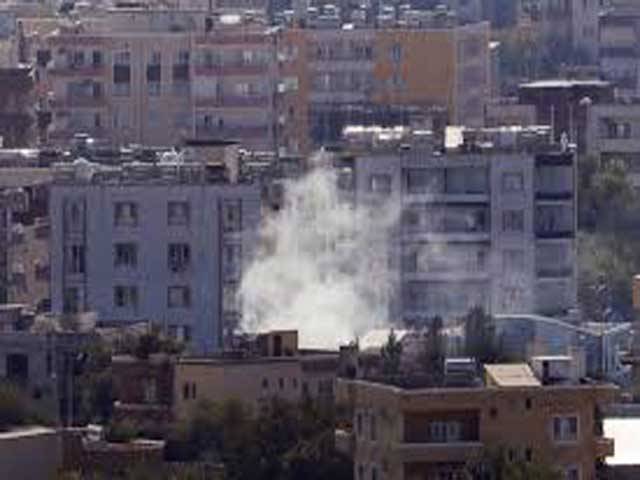CEYLANPINAR - Fighting continued Friday in and around a northeast Syrian border town at the center of the fight between Turkey and Kurdish forces, despite a U.S.-brokered cease-fire that went into effect overnight.
The town of Ras al-Ayn, scene of some of the fiercest fighting of the Turkish invasion, was emerging as an immediate test for the five-day cease-fire agreed on by Washington and Ankara. Before the deal’s announcement, Turkish-backed forces had encircled the town and were battling fierce resistance from Kurdish fighters inside.
A spokesman for the Kurdish-led fighters said Friday they were not withdrawing from Ras al-Ayn because Turkish forces are still besieging and shelling it. Elsewhere along the border, calm seemed to prevail.
Shelling hit in and around Ras al-Ayn on Friday morning, raising columns of smoke, seen by an Associated Press journalist in Ceylanpinar on the Turkish side of the border, but none was seen after noon, and only sporadic gunfire was heard from inside the town.
The Britain-based Syrian Observatory for Human Rights and the Rojava Information Center said fighting continued into the afternoon as Turkish-backed Syrian fighters clashed with Kurdish forces in villages on the outskirts of Ras al-Ayn. The Kurdish-led force said five of its fighters were killed and a number of civilians wounded in a Turkish airstrike on one of the villages.
Other activists reported a new exodus of civilians from the villages. Gun battles and shelling continued around a hospital in the center of Ras al-Ayn, and injured inside could not be evacuated, said Mustafa Bali, spokesman for the Kurdish-led Syrian Democratic Forces. The Kurdish Red Crescent said it was unable to enter the town to evacuate wounded because of fighting.
Turkish President Recep Tayyip Erdogan denied any fighting took place Friday and said Kurdish fighters had begun withdrawing. Bali said that was not true. “The Turkish land and air bombing continue in Ras al-Ayn,” he said.
A senior U.S. official said they were awaiting confirmation on the reported fighting. The official said it takes time for information to filter down to field units especially for forces without strong command and control. He spoke on condition of anonymity because he was not authorized to speak to the press.
The cease-fire agreement — reached after hours of negotiations in Turkey’s capital between Erdogan and U.S. Vice President Mike Pence — requires the Kurdish fighters to vacate a swath of territory in Syria along the Turkish border. That arrangement would largely solidify the position Turkey has gained after days of fighting. The Turks and the Kurds appear to disagree on the size of the area covered by the cease-fire. Turkey calls it a “pause” not a cease-fire.
It remains unclear if the Kurdish-led force was on board with pulling back even if a pause in fighting firmly takes hold. Pence said the U.S. was already coordinating with it on a withdrawal. But American sway with the group has diminished after President Donald Trump turned his back on it by withdrawing U.S. soldiers from northeast Syria, opening the way for Turkey to launch its invasion 10 days ago.
The Kurdish-led force’s commander, Mazloum Abdi, said Thursday night that it would abide by the cease-fire and “do our best to make it successful.” He did not mention any withdrawal. Asked about a withdrawal, a force spokesman, Mervan, said “so far there is nothing,” pointing to the continuing siege of Ras al-Ayn. “It seems that under this deal they want to commit more massacres,” he said. He uses a nom de guerre in accordance with the group’s regulations.
A member of the Syrian Kurdish force ruled out any pull-back from border towns, calling the U.S. deal with Turkey an “insult” and saying “no way this will work.” “They think we will just leave our land and our people to Turks if we are asked,” he said. “They can come and take the land by force. Nobody should expect us to leave our land.”
“How does the U.S. think to enforce a deal without presence on the ground?” he added, speaking on condition of anonymity because he was not authorized to speak to reporters. Elsewhere, no fighting was heard Friday along the stretch of the border that has been the main theater of the Turkish assault, running from Ras al-Ayn about 125 kilometers (75 miles) west to the Turkish-held town of Tal Abyad.
Kurdish fighters have already been driven out of much, but not all, of that territory.
Trump framed the U.S. cease-fire deal with Turkey as “a great day for civilization,” but it aims to patch up a foreign policy crisis widely seen to be of his own making. Turkish troops and their allied Syrian fighters launched the offensive two days after Trump suddenly announced he was withdrawing American troops from the border area. The Kurdish-led forces have since invited the Syrian government’s military, backed by Russia, to deploy there to protect them from Turkey. Syrian troops have already rolled into several key points along the border.
The Kurds were U.S. allies in the fight against the Islamic State since 2014, but Turkey considers the Kurdish fighters terrorists because of their links to outlawed Kurdish rebels fighting inside Turkey since the 1980s. Turkey has said its security depends on clearing them out of a border “safe zone.”
Turkey’s pro-government dominated media hailed the cease-fire agreement as a clear win for Erdogan. “Great Victory” read Yeni Safak’s banner headline. “Turkey got everything it wanted.” Sabah newspaper headlined: “We won both on the field and on the (negotiating) table.”






